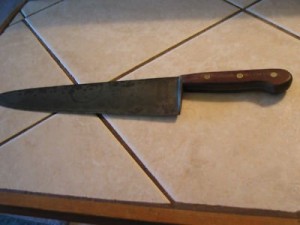 Last week, in one of Martha Stewart’s Q&A articles at Cincinnati.com, a reader raised an important aspect in maintaining knives: what material the blade is made out of.
Last week, in one of Martha Stewart’s Q&A articles at Cincinnati.com, a reader raised an important aspect in maintaining knives: what material the blade is made out of.
Whereas most modern kitchen knives are created out of stainless steel, the blades of many older models are other materials, such as carbon steel.The problem with carbon steel blades, as the reader had found out, is that they are vulnerable to discoloration.
Stewart’s solution for the brown blade was fairly simple:
You can brighten your knives’ blades by polishing them with fine steel wool and Noxon metal polish. In addition, collecting editor Fritz Karch recommends hand-washing the knives after each use and drying them immediately to prevent rust. Then, with a cloth or paper towel, wipe a thin layer of mineral oil onto the blade to protect the steel from corrosion. Finally, store them in a location with low humidity.
Although the question was aimed at kitchen cutlery, this topic is something all knife owners should consider. As Stewart pointed out, always cleaning carbon steel blades, whether kitchen cutlery or hunting knives, is crucial to keeping its color and durability.
Each blade material has specific tips to remember. For example, stainless steel blades have the potential to rust in certain environments, so drying and occasionally scrubbing them with abrasive cloth will preserve the blades’ integrity.
For ceramic blades, found in some folding knives and kitchen cutlery, they will not rust or suffer discoloration, but they are more susceptible to scratches and breaks.
Whether plastic, titanium, stainless steel or carbon steel, it’s important for knife owners to understand the vulnerabilities of each blade material.




Leave a Reply